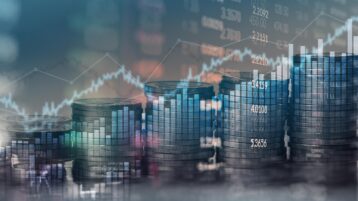Some of the biggest names in the semiconductor space are investing billions of dollars to become leaders in artificial intelligence. Julien Nono-Womdim, Semiconductor Analyst at TD Asset Management, discusses the impact of AI on the sector and potential opportunities for investors.
Print Transcript
* Well, semiconductor stocks have had a strong run in recent months amid all this buzz around the potential for artificial intelligence. Joining us now to discuss whether that trend can continue, Julien Nono-Womdim, Semiconductor Analyst at TD Asset Management. Julien, great to have you back on the show.
* Hey, Greg.
* So definitely you look at these charts for a lot of these names in the semi space and the chips, and they've had a pretty big run. What's going on here?
* You're right. It's been a pretty significant run. Semiconductor stocks are up 37% on the year. That's incredible. I'd say there are three dynamics at play. The first one is the cycle is approaching a bottom. Secondly, AI is like a dog that won't stop barking. And lastly, the quality of the businesses in semiconductors relative to 10, 15 years ago has improved significantly.
Let's parse those. Cycle bottom-- we are now 10 months, as per the most recent data points, into a semiconductor contraction, as per the Semiconductor Industry Association. Typically, these contractions last anywhere between 8 to 12 months. And the market is starting to underwrite a new cycle. And as you talked about, AI has made some significant buzz in terms of the investments that are being made.
You have companies like Microsoft, Meta, Google that are investing significantly in AI. And that is going to determine the winners and losers of tomorrow. And that is all semiconductor intensive. And lastly, like I said, the biggest surprise this quarter from a reporting standpoint is despite the weakness in semiconductor demand, margins and gross margins in particular have held really well across the industry. And I think that's a testament to the fact that semiconductors are not a commodity. They are a critical input into the economy.
* OK, so that's interesting that you have three pillars there because all anyone wants to talk about is AI. So I won't make the deadly sin of only wanting to talk about AI. Let's talk about ChatGPT. I feel like people who follow technology have known about artificial intelligence for a while and perhaps what it could do. And then suddenly ChatGPT brings it to the mainstream, where the average person says, oh, I play with AI all the time now.
* Yes, yes, yes. Let's think about the '80s and '90s, we had the advent of the personal computer, right? As we moved into the 2000s and 2010s, you had the mobile phone and then the smartphone. And over the last several years we've been wondering what comes next. You heard about IoT, last year the metaverse was all the rage. And finally, this picture of the future which was very blurry is starting to become clear.
And what drove that clarity is generative AI broadly speaking but ChatGPT. We're getting a glimpse into what the future might look like from a productivity gain standpoint. And all these really drive continued growth in semiconductor intensity across the economy, and therefore positive for companies within the space. And obviously, the likes of Nvidia and AMD.
* I think of ChatGPT and how it is public facing, and any member of the public can get an account like I did a while ago to start playing with it. Is that just sort of the tip of the iceberg when we're talking about AI and why people are excited about this space?
* That is precisely what I'm saying. It is the tip of the iceberg. I think the excitement is because it's tangible. You and I can play with ChatGPT and see the applications. But really the investments that have come on the back of generative AI from the likes of Microsoft, as I mentioned, or Google, et cetera. On the one hand, they're going to be a revenue generating opportunity. And on the other hand, they're going to be threats for some businesses. And so this investment, as I said, is going to really determine the winners and losers of tomorrow. I mean, I believe you have an iPhone.
* I do, yeah.
* In the smartphone era, Apple captured the vast majority of that ecosystem. If we step back to the early 2000s, everyone had a Nokia, right? And so this evolution of technology is partly driven by ChatGPT and generative AI. But ultimately, if we take a step back, it is a glimpse into some of the applications that will be available to us.
* Now when it comes to semiconductors and chip makers there's more than one name out there building these chips. Yet Nvidia seems to be the poster child I guess of all this AI hype. What's going on with Nvidia? In particular, why it seems to reap the rewards at least at this stage of it?
* Sure. Let's take a step back. Last year the stock was down north of 60% peak to trough. Yes, the stock is up over 160% this year. There are three dynamics at play I would say. Number one is their gaming business, which provides games for PC players, et cetera, graphics cards for PC players, et cetera, appears to have bottomed. That's number one.
Number two, data center is starting to represent a bigger proportion of that company's business, prepandemic or south of 50%. And it looks like we're going to end the year north of 70%. But I think the most important dynamic that's going on is that you may have heard of the CPU, or the central processing unit, right? Historically, the CPU was the brains behind computers. And what's going on today is that computers and more specifically data centers are going through a brain transplant. The CPU is being replaced by the GPU because GPUs are better at processing AI type of application.
* These are graphics processing units, right? I thought of them are related to gaming, but now there seems to be this AI use for them.
* They are very good at doing what's called parallel processing, i.e. performing small calculations simultaneously as opposed to serial processing. And AI is essentially that. Performing a bunch of different calculations simultaneously. And Nvidia is the overwhelming leader in GPU hardware and software. So they're capturing for now a vast majority of that ecosystem. And consequently, the stock is reacting in kind. But like I said, there are three dynamics not just the AI element.
* Now, the AI element gets all the headlines. But what if, I mean, you say there's other elements of play in the end, these chips whether it's Nvidia or Intel or AMD, some of the companies that we talk about on the show, go into devices. What if there's an economic slowdown? What if there's a recession and we don't buy as many devices? I mean, what does that mean for semis?
* Yeah, it's a good question. I think historically semiconductor demand, you can split it up into a pie that is half consumer PCs and smartphones, and then the other half is a hodgepodge of data center, industrial, automotive. And you're right that the consumer has seen a pretty significant slowdown partly driven by inflation, but also driven by the binge that was occurring during the pandemic in terms of people just ordering devices.
I think it's pretty clear today that that slice of the pie that is dedicated to data center communication infrastructure, that's going to grow because companies, as I said earlier, Microsoft, Google are making strategic long-term investments that are driving the value of these businesses five, 10, 15, 20 years out. So that's one element. The other element is that on the automotive and infrastructure piece of the pie, we're talking about electrification. We're talking about greening the economy. All of those are driving incremental semiconductor content.
And on the consumer side, for now it appears we've reached a bottom. Whether we recover from year remains to be seen, but the other half of the overall demand pie can drive growth into the quarters ahead. And I think that's what the market is pricing in.
[MUSIC PLAYING]
* Hey, Greg.
* So definitely you look at these charts for a lot of these names in the semi space and the chips, and they've had a pretty big run. What's going on here?
* You're right. It's been a pretty significant run. Semiconductor stocks are up 37% on the year. That's incredible. I'd say there are three dynamics at play. The first one is the cycle is approaching a bottom. Secondly, AI is like a dog that won't stop barking. And lastly, the quality of the businesses in semiconductors relative to 10, 15 years ago has improved significantly.
Let's parse those. Cycle bottom-- we are now 10 months, as per the most recent data points, into a semiconductor contraction, as per the Semiconductor Industry Association. Typically, these contractions last anywhere between 8 to 12 months. And the market is starting to underwrite a new cycle. And as you talked about, AI has made some significant buzz in terms of the investments that are being made.
You have companies like Microsoft, Meta, Google that are investing significantly in AI. And that is going to determine the winners and losers of tomorrow. And that is all semiconductor intensive. And lastly, like I said, the biggest surprise this quarter from a reporting standpoint is despite the weakness in semiconductor demand, margins and gross margins in particular have held really well across the industry. And I think that's a testament to the fact that semiconductors are not a commodity. They are a critical input into the economy.
* OK, so that's interesting that you have three pillars there because all anyone wants to talk about is AI. So I won't make the deadly sin of only wanting to talk about AI. Let's talk about ChatGPT. I feel like people who follow technology have known about artificial intelligence for a while and perhaps what it could do. And then suddenly ChatGPT brings it to the mainstream, where the average person says, oh, I play with AI all the time now.
* Yes, yes, yes. Let's think about the '80s and '90s, we had the advent of the personal computer, right? As we moved into the 2000s and 2010s, you had the mobile phone and then the smartphone. And over the last several years we've been wondering what comes next. You heard about IoT, last year the metaverse was all the rage. And finally, this picture of the future which was very blurry is starting to become clear.
And what drove that clarity is generative AI broadly speaking but ChatGPT. We're getting a glimpse into what the future might look like from a productivity gain standpoint. And all these really drive continued growth in semiconductor intensity across the economy, and therefore positive for companies within the space. And obviously, the likes of Nvidia and AMD.
* I think of ChatGPT and how it is public facing, and any member of the public can get an account like I did a while ago to start playing with it. Is that just sort of the tip of the iceberg when we're talking about AI and why people are excited about this space?
* That is precisely what I'm saying. It is the tip of the iceberg. I think the excitement is because it's tangible. You and I can play with ChatGPT and see the applications. But really the investments that have come on the back of generative AI from the likes of Microsoft, as I mentioned, or Google, et cetera. On the one hand, they're going to be a revenue generating opportunity. And on the other hand, they're going to be threats for some businesses. And so this investment, as I said, is going to really determine the winners and losers of tomorrow. I mean, I believe you have an iPhone.
* I do, yeah.
* In the smartphone era, Apple captured the vast majority of that ecosystem. If we step back to the early 2000s, everyone had a Nokia, right? And so this evolution of technology is partly driven by ChatGPT and generative AI. But ultimately, if we take a step back, it is a glimpse into some of the applications that will be available to us.
* Now when it comes to semiconductors and chip makers there's more than one name out there building these chips. Yet Nvidia seems to be the poster child I guess of all this AI hype. What's going on with Nvidia? In particular, why it seems to reap the rewards at least at this stage of it?
* Sure. Let's take a step back. Last year the stock was down north of 60% peak to trough. Yes, the stock is up over 160% this year. There are three dynamics at play I would say. Number one is their gaming business, which provides games for PC players, et cetera, graphics cards for PC players, et cetera, appears to have bottomed. That's number one.
Number two, data center is starting to represent a bigger proportion of that company's business, prepandemic or south of 50%. And it looks like we're going to end the year north of 70%. But I think the most important dynamic that's going on is that you may have heard of the CPU, or the central processing unit, right? Historically, the CPU was the brains behind computers. And what's going on today is that computers and more specifically data centers are going through a brain transplant. The CPU is being replaced by the GPU because GPUs are better at processing AI type of application.
* These are graphics processing units, right? I thought of them are related to gaming, but now there seems to be this AI use for them.
* They are very good at doing what's called parallel processing, i.e. performing small calculations simultaneously as opposed to serial processing. And AI is essentially that. Performing a bunch of different calculations simultaneously. And Nvidia is the overwhelming leader in GPU hardware and software. So they're capturing for now a vast majority of that ecosystem. And consequently, the stock is reacting in kind. But like I said, there are three dynamics not just the AI element.
* Now, the AI element gets all the headlines. But what if, I mean, you say there's other elements of play in the end, these chips whether it's Nvidia or Intel or AMD, some of the companies that we talk about on the show, go into devices. What if there's an economic slowdown? What if there's a recession and we don't buy as many devices? I mean, what does that mean for semis?
* Yeah, it's a good question. I think historically semiconductor demand, you can split it up into a pie that is half consumer PCs and smartphones, and then the other half is a hodgepodge of data center, industrial, automotive. And you're right that the consumer has seen a pretty significant slowdown partly driven by inflation, but also driven by the binge that was occurring during the pandemic in terms of people just ordering devices.
I think it's pretty clear today that that slice of the pie that is dedicated to data center communication infrastructure, that's going to grow because companies, as I said earlier, Microsoft, Google are making strategic long-term investments that are driving the value of these businesses five, 10, 15, 20 years out. So that's one element. The other element is that on the automotive and infrastructure piece of the pie, we're talking about electrification. We're talking about greening the economy. All of those are driving incremental semiconductor content.
And on the consumer side, for now it appears we've reached a bottom. Whether we recover from year remains to be seen, but the other half of the overall demand pie can drive growth into the quarters ahead. And I think that's what the market is pricing in.
[MUSIC PLAYING]



























